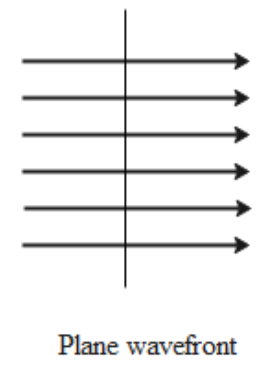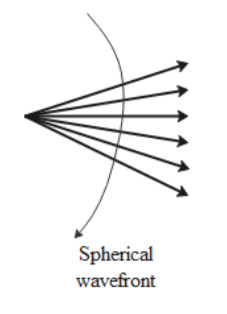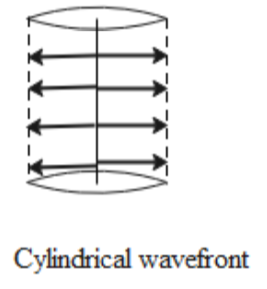
Which of the following generates a plane wavefront?
A).
B).
C).
D). None of these
Answer
437.6k+ views
Hint: A wavefront is defined as the locus of all points having the same phase at a given instant of time. The shape of the wavefront depends on the shape of the source of the disturbance. There are three types of wavefronts i.e., spherical wavefront, plane wavefront, and cylindrical wavefront.
Complete step by step answer:
Plane Wavefront: When the small part of the spherical or cylindrical wavefront originates from a distant source, like infinity, then the wavefront which is obtained is known as a plane wavefront.

For example: Rays coming from infinity, like Sun.
Plane wavefront is generated from a very distant source.
Hence, the correct option is D, i.e., None of these.
Additional Information:
Spherical Wavefront: When the source of light is a point source then the wavefront formed will be spherical.

Point source means the source of light is so small that it is considered as a point. It can be considered as dimensionless.
For example: Ripples in water are in the form of concentric circles which are spherical wavefronts.
Cylindrical Wavefront: When the source of disturbance is a slit (i.e. line source) then the wavefront is cylindrical because all the points are equidistant from the source and they lie on the surface of the cylinder.

For example: When the rays of light fall on a lens after coming out of the lens, they will converge at a point.
The waves are bending and converging at a point so the shape of the wavefront is in the form of a cylinder.
Note: Students need to understand the formation of various types of wavefronts comprehensively because by doing so, they can easily classify the various types of wavefronts by observing the shape of the source. In this question, students do not need to be confused with other options.
Complete step by step answer:
Plane Wavefront: When the small part of the spherical or cylindrical wavefront originates from a distant source, like infinity, then the wavefront which is obtained is known as a plane wavefront.

For example: Rays coming from infinity, like Sun.
Plane wavefront is generated from a very distant source.
Hence, the correct option is D, i.e., None of these.
Additional Information:
Spherical Wavefront: When the source of light is a point source then the wavefront formed will be spherical.

Point source means the source of light is so small that it is considered as a point. It can be considered as dimensionless.
For example: Ripples in water are in the form of concentric circles which are spherical wavefronts.
Cylindrical Wavefront: When the source of disturbance is a slit (i.e. line source) then the wavefront is cylindrical because all the points are equidistant from the source and they lie on the surface of the cylinder.

For example: When the rays of light fall on a lens after coming out of the lens, they will converge at a point.
The waves are bending and converging at a point so the shape of the wavefront is in the form of a cylinder.
Note: Students need to understand the formation of various types of wavefronts comprehensively because by doing so, they can easily classify the various types of wavefronts by observing the shape of the source. In this question, students do not need to be confused with other options.
Recently Updated Pages
Master Class 12 Economics: Engaging Questions & Answers for Success

Master Class 12 Maths: Engaging Questions & Answers for Success

Master Class 12 Biology: Engaging Questions & Answers for Success

Master Class 12 Physics: Engaging Questions & Answers for Success

Master Class 4 Maths: Engaging Questions & Answers for Success

Master Class 4 English: Engaging Questions & Answers for Success

Trending doubts
Give 10 examples of unisexual and bisexual flowers

Draw a labelled sketch of the human eye class 12 physics CBSE

a Tabulate the differences in the characteristics of class 12 chemistry CBSE

Differentiate between homogeneous and heterogeneous class 12 chemistry CBSE

Why is the cell called the structural and functional class 12 biology CBSE

Differentiate between insitu conservation and exsitu class 12 biology CBSE




